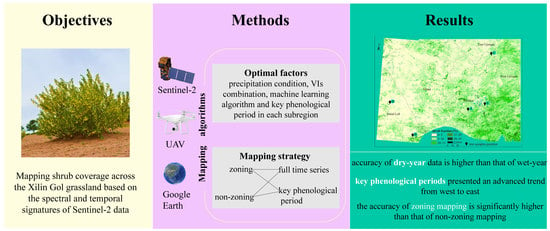Mapping Shrub Coverage in Xilin Gol Grassland with Multi-Temporal Sentinel-2 Imagery
Abstract
:1. Introduction
2. Study Area and Materials
2.1. Study Area
2.2. Data Collection and Preprocessing
2.3. Sample Data Collection and Classification
3. Methodology
3.1. Study Area Zoning
3.2. Vegetation Indices
3.3. Regression Methods and Parameterization
3.4. Model Training for Shrub Coverage Estimation
3.4.1. General Training and Validation Strategies
3.4.2. Key Phenological Period Evaluation
3.4.3. Mapping Strategies for the Whole Study Area
- Strategy1 (Stgy.1): zoning + full time series of VIs, that is, the full time series of optimal VIs are used to construct the model in each subregion, and then the partition results are combined into the whole region results.
- Strategy2 (Stgy.2): zoning + key phenological period, that is, the top five key phenological periods of optimal VIs are selected to construct the model in each subregion.
- Strategy3 (Stgy.3): non-zoning + full time series, that is, all the optimal VIs time series in the subregions are put together to construct the model with all the training samples.
- Strategy4 (Stgy.4): non-zoning + key phenological period, that is, the top five key phenological periods of all optimal VIs selected in each subregion are put together to construct the model.
4. Results
4.1. Zoning Result of the Study Area
4.2. The Optimal Factors in Each Subregion
4.3. The Key Phenological Periods in Each Subregion
4.4. Comparison of Shrub Coverage Mapping Strategies
5. Discussion
5.1. Reliability of Shrub Coverage Mapping Result
5.2. Significance of Zoning and Feature Selection
5.3. Spatial Variability of Optimal VIs and Key Phenological Period
5.4. Uncertainties and Deficiencies
6. Conclusions
Author Contributions
Funding
Data Availability Statement
Conflicts of Interest
References
- Van Auken, O.W. Causes and consequences of woody plant encroachment into western North American grasslands. J. Environ. Manag. 2009, 90, 2931–2942. [Google Scholar] [CrossRef] [PubMed]
- Fan, Y.; Li, X.; Huang, H.; Wu, X.; Yu, K.; Wei, J.; Zhang, C.; Wang, P.; Hu, X.; D’Odorico, P. Does phenology play a role in the feedbacks underlying shrub encroachment? Sci. Total Environ. 2019, 657, 1064–1073. [Google Scholar] [CrossRef] [PubMed]
- Tu, Y.; Liu, Y.; Zhu, Y.; Yang, X.; Zhang, K. Effects of shrub encroachment in Xilin Gol Steppe on the species diversity and biomass of herbaceous communities in shrub interspaces area. J. Beijing For. Univ. 2019, 41, 57–67. [Google Scholar] [CrossRef]
- Knapp, A.K.; Briggs, J.M.; Collins, S.L.; Archer, S.R.; Bret-Harte, M.S.; Ewers, B.E.; Peters, D.P.; Young, D.R.; Shaver, G.R.; Pendall, E.; et al. Shrub encroachment in North American grasslands: Shifts in growth form dominance rapidly alters control of ecosystem carbon inputs. Glob. Chang. Biol. 2008, 14, 615–623. [Google Scholar] [CrossRef]
- O’Connor, T.G.; Puttick, J.R.; Hoffman, M.T. Bush encroachment in southern Africa: Changes and causes. Afr. J. Range Forage Sci. 2014, 31, 67–88. [Google Scholar] [CrossRef]
- Maestre, F.T.; Bowker, M.A.; Puche, M.D.; Belén Hinojosa, M.; Martínez, I.; García-Palacios, P.; Castillo, A.P.; Soliveres, S.; Luzuriaga, A.L.; Sánchez, A.M.; et al. Shrub encroachment can reverse desertification in semi-arid Mediterranean grasslands. Ecol. Lett. 2009, 12, 930–941. [Google Scholar] [CrossRef]
- Fensham, R.J.; Fairfax, R.J.; Archer, S.R. Rainfall, land use and woody vegetation cover change in semi-arid Australian savanna. J. Ecol. 2005, 93, 596–606. [Google Scholar] [CrossRef]
- Cao, X.; Liu, Y.; Liu, Q.; Cui, X.; Chen, X.; Chen, J. Estimating the age and population structure of encroaching shrubs in arid/semiarid grasslands using high spatial resolution remote sensing imagery. Remote Sens. Environ. 2018, 216, 572–585. [Google Scholar] [CrossRef]
- Guo, J.; Chen, S.; Xu, B.; Sheng, G.; Jin, Y.; Zhang, Y.; Yang, X. Remote sensing monitoring of grassland vegetation green up based on SPOT-VGT in Xilingol League. Geogr. Res. 2017, 36, 37–48. [Google Scholar] [CrossRef]
- Zhou, D. Caragana microphalla Lam encroachment grassland in Inner Mongolia. Grassl. Prataculture 1990, 3, 17–19. [Google Scholar]
- Han, Y.; Niu, J.; Zhang, Q.; Dong, J.; Zhang, X.; Kang, S. The changing of vegetation pattern and its driven forces of grassland in Xilin river basin in thirty years. Chin. J. Grassl. 2014, 36, 70–77. [Google Scholar]
- Yan, B.; Lv, S.; Wang, Z.; Han, G. The advance of shrub encroachment in grassland and its impact on ecosystem. Chin. J. Grassl. 2019, 41, 95–101. [Google Scholar]
- Sun, B.; Li, Z.; Gao, W.; Zhang, Y.; Gao, Z.; Song, Z.; Qin, P.; Tian, X. Identification and assessment of the factors driving vegetation degradation/regeneration in drylands using synthetic high spatiotemporal remote sensing data—A case study in Zhenglanqi, Inner Mongolia, China. Ecol. Indic. 2019, 107, 105614. [Google Scholar] [CrossRef]
- Peng, H.; Li, X.; Tong, S. Effects of shrub encroachment on biomass and biodiversity in the typical steppe of Inner Mongolia. Acta Ecol. Sin. 2013, 33, 7221–7229. [Google Scholar] [CrossRef]
- Briggs, J.M.; Knapp, A.K.; Blair, J.M.; Heisler, J.L.; Hoch, G.A.; Lett, M.S.; McCarron, J.K. An ecosystem in transition: Causes and consequences of the conversion of mesic grassland to shrubland. Bioscience 2005, 55, 243–254. [Google Scholar] [CrossRef]
- Howard, K.S.C.; Eldridge, D.J.; Soliveres, S. Positive effects of shrubs on plant species diversity do not change along a gradient in grazing pressure in an arid shrubland. Basic Appl. Ecol. 2012, 13, 159–168. [Google Scholar] [CrossRef]
- Peng, H.; Li, X.; Tong, S. Advance in shrub encroachment in arid and semiarid region. Acta Prataculturae Sin. 2014, 23, 313–322. [Google Scholar]
- Gao, Q.; Liu, T. Causes and consequences of shrub encroachment in arid and semiarid region: A disputable issue. Arid Land Geogr. 2015, 38, 1202–1212. [Google Scholar]
- Ma, L.; Zhou, Y.; Chen, J.; Cao, X.; Chen, X. Estimation of fractional vegetation cover in semiarid areas by integrating endmember reflectance purification into nonlinear spectral mixture analysis. IEEE Geosci. Remote Sens. Lett. 2015, 12, 1175–1179. [Google Scholar] [CrossRef]
- Chen, J.; Chen, Y.; He, C.; Shi, P. Sub-pixel model for vegetation fraction estimation based on land cover classification. J. Remote Sens. 2001, 5, 416–422. [Google Scholar] [CrossRef]
- Jiapaer, G.; Chen, X.; Bao, A. Coverage extraction and up-scaling of sparse desert vegetation in arid area. Chin. J. Appl. Ecol. 2009, 20, 2925–2934. [Google Scholar]
- Cao, X.; Liu, Y.; Cui, X.; Chen, J.; Chen, X. Mechanisms, monitoring and modeling of shrub encroachment into grassland: A review. Int. J. Digit. Earth 2019, 12, 625–641. [Google Scholar] [CrossRef]
- Brandt, M.; Hiernaux, P.; Tagesson, T.; Verger, A.; Rasmussen, K.; Diouf, A.A.; Mbow, C.; Mougin, E.; Fensholt, R. Woody plant cover estimation in drylands from Earth Observation based seasonal metrics. Remote Sens. Environ. 2016, 172, 28–38. [Google Scholar] [CrossRef]
- Macander, M.J.; Frost, G.V.; Nelson, P.R.; Swingley, C.S. Regional quantitative cover mapping of tundra plant functional types in Arctic Alaska. Remote Sens. 2017, 9, 1024. [Google Scholar] [CrossRef]
- Xian, G.; Homer, C.; Rigge, M.; Shi, H.; Meyer, D. Characterization of shrubland ecosystem components as continuous fields in the northwest United States. Remote Sens. Environ. 2015, 168, 286–300. [Google Scholar] [CrossRef]
- Baumann, M.; Levers, C.; Macchi, L.; Bluhm, H.; Waske, B.; Gasparri, N.I.; Kuemmerle, T. Mapping continuous fields of tree and shrub cover across the Gran Chaco using Landsat 8 and Sentinel-1 data. Remote Sens. Environ. 2018, 216, 201–211. [Google Scholar] [CrossRef]
- Cao, C.; Chen, W.; Li, G.; Jia, H.; Ji, W.; Xu, M.; Gao, M.; Ni, X.; Zhao, J.; Zheng, S.; et al. The retrieval of shrub fractional cover based on a geometric-optical model in combination with linear spectral mixture analysis. Can. J. Remote Sens. 2011, 37, 348–358. [Google Scholar] [CrossRef]
- Liu, T.; Zhao, X.; Shen, M.; Hu, H.; Huang, W.; Fang, J. Spectral feature differences between shrub and grass communities and shrub coverage retrieval in shrub-encroached grassland in Xianghuang Banner, Nei Mongol, China. Chin. J. Plant Ecol. 2016, 40, 969–979. [Google Scholar] [CrossRef]
- Zhang, W.; Brandt, M.; Wang, Q.; Prishchepov, A.V.; Tucker, C.J.; Li, Y.; Lyu, H.; Fensholt, R. From woody cover to woody canopies: How Sentinel-1 and Sentinel-2 data advance the mapping of woody plants in savannas. Remote Sens. Environ. 2019, 234, 111465. [Google Scholar] [CrossRef]
- Dong, Y.; Yan, H.; Wang, N.; Huang, M.; Hu, Y. Automatic identification of shrub-encroached grassland in the Mongolian plateau based on UAS remote sensing. Remote Sens. 2019, 11, 1623. [Google Scholar] [CrossRef]
- Selkowitz, D.J. A comparison of multi-spectral, multi-angular, and multi-temporal remote sensing datasets for fractional shrub canopy mapping in Arctic Alaska. Remote Sens. Environ. 2010, 114, 1338–1352. [Google Scholar] [CrossRef]
- Chopping, M.; Su, L.; Rango, A.; Martonchik, J.V.; Peters, D.P.C.; Laliberte, A. Remote sensing of woody shrub cover in desert grasslands using MISR with a geometric-optical canopy reflectance model. Remote Sens. Environ. 2008, 112, 19–34. [Google Scholar] [CrossRef]
- Xie, L.; Ma, C.; Guo, H.; Li, Q.; Gao, Y. Distribution pattern of Caragana species under the influence of climate gradient in the Inner Mongolia region, China. J. Arid Land 2014, 6, 311–323. [Google Scholar] [CrossRef]
- Zhou, Y.; Chen, J.; Chen, X.; Cao, X.; Zhu, X. Two important indicators with potential to identify Caragana microphylla in Xilin Gol grassland from temporal MODIS data. Ecol. Indic. 2013, 34, 520–527. [Google Scholar] [CrossRef]
- Soubry, I.; Guo, X. Identification of the optimal season and spectral regions for shrub cover estimation in Grasslands. Sensors 2021, 21, 3098. [Google Scholar] [CrossRef]
- Chen, J.; Jönsson, P.; Tamura, M.; Gu, Z.; Matsushita, B.; Eklundh, L. A simple method for reconstructing a high-quality NDVI time-series data set based on the Savitzky-Golay filter. Remote Sens. Environ. 2004, 91, 332–344. [Google Scholar] [CrossRef]
- Abatzoglou, J.T.; Dobrowski, S.Z.; Parks, S.A.; Hegewisch, K.C. TerraClimate, a high-resolution global dataset of monthly climate and climatic water balance from 1958–2015. Sci. Data 2018, 5, 170191. [Google Scholar] [CrossRef]
- Gong, P.; Liu, H.; Zhang, M.; Li, C.; Wang, J.; Huang, H.; Clinton, N.; Ji, L.; Li, W.; Bai, Y.; et al. Stable classification with limited sample: Transferring a 30-m resolution sample set collected in 2015 to mapping 10-m resolution global land cover in 2017. Sci. Bull. 2019, 64, 370–373. [Google Scholar] [CrossRef]
- Tian, J.; Chen, D.M. Optimization in multi-scale segmentation of high-resolution satellite images for artificial feature recognition. Int. J. Remote Sens. 2007, 28, 4625–4644. [Google Scholar] [CrossRef]
- Rouse, J., Jr.; Haas, R.H.; Schell, J.A.; Deering, D.W. Monitoring vegetation systems in the Great Plains with ERTS. In Proceedings of the 3rd ERTS Symposium, Washington, DC, USA, 10–14 December 1973; pp. 309–317. [Google Scholar]
- Gitelson, A.A.; Kaufman, Y.J.; Merzlyak, M.N. Use of a green channel in remote sensing of global vegetation from EOS-MODIS. Remote Sens. Environ. 1996, 58, 289–298. [Google Scholar] [CrossRef]
- Van Deventer, A.P.; Ward, A.D.; Gowda, P.M.; Lyon, J.G. Using thematic mapper data to identify contrasting soil plains and tillage practices. Photogramm. Eng. Remote Sens. 1997, 63, 87–93. [Google Scholar]
- Qi, J.; Marsett, R.; Heilman, P.; Bieden-bender, S.; Moran, S.; Goodrich, D.; Weltz, M. RANGES improves satellite-based information and land cover assessments in southwest United States. Eos 2002, 83, 601–606. [Google Scholar] [CrossRef]
- Jiang, Z.; Huete, A.R.; Didan, K.; Miura, T. Development of a two-band enhanced vegetation index without a blue band. Remote Sens. Environ. 2008, 112, 3833–3845. [Google Scholar] [CrossRef]
- Qi, J.; Chehbouni, A.; Huete, A.R.; Kerr, Y.H.; Sorooshian, S. A modify soil adjust vegetation index. Remote Sens. Environ. 1994, 48, 119–126. [Google Scholar] [CrossRef]
- Wang, C.; Chen, J.; Wu, J.; Tang, Y.; Shi, P.; Black, T.A.; Zhu, K. A snow-free vegetation index for improved monitoring of vegetation spring green-up date in deciduous ecosystems. Remote Sens. Environ. 2017, 196, 1–12. [Google Scholar] [CrossRef]
- Yang, W.; Kobayashi, H.; Wang, C.; Shen, M.; Chen, J.; Matsushita, B.; Tang, Y.; Kim, Y.; Bret-Harte, M.S.; Zona, D.; et al. A semi-analytical snow-free vegetation index for improving estimation of plant phenology in tundra and grassland ecosystems. Remote Sens. Environ. 2019, 228, 31–44. [Google Scholar] [CrossRef]
- Wilson, E.H.; Sader, S.A. Detection of forest harvest type using multiple dates of Landsat TM imagery. Remote Sens. Environ. 2002, 80, 385–396. [Google Scholar] [CrossRef]
- Zhang, H.; Kang, J.; Xu, X.; Zhang, L. Accessing the temporal and spectral features in crop type mapping using multi-temporal Sentinel-2 imagery: A case study of Yi’an County, Heilongjiang province, China. Comput. Electron. Agric. 2020, 176, 105618. [Google Scholar] [CrossRef]
- Verrelst, J.; Camps-Valls, G.; Muñoz-Marí, J.; Rivera, J.P.; Veroustraete, F.; Clevers, J.G.P.W.; Moreno, J. Optical remote sensing and the retrieval of terrestrial vegetation bio-geophysical properties—A review. ISPRS J. Photogramm. Remote Sens. 2015, 108, 273–290. [Google Scholar] [CrossRef]
- Wang, Z.; Townsend, P.A.; Schweiger, A.K.; Couture, J.J.; Singh, A.; Hobbie, S.E.; Cavender-Bares, J. Mapping foliar functional traits and their uncertainties across three years in a grassland experiment. Remote Sens. Environ. 2019, 221, 405–416. [Google Scholar] [CrossRef]
- Heydari, S.S.; Mountrakis, G. Effect of classifier selection, reference sample size, reference class distribution and scene heterogeneity in per-pixel classification accuracy using 26 Landsat sites. Remote Sens. Environ. 2018, 204, 648–658. [Google Scholar] [CrossRef]
- Ma, C.C.; Gao, Y.B.; Liu, H.F.; Wang, J.L.; Guo, H.Y. Interspecific transition among Caragana microphylla, Caragana davazamcii and Caragana korshinskii along geographic gradient. I. Ecological and RAPD evidence. Acta Bot. Sin. 2003, 45, 1218–1227. [Google Scholar]
- Liu, X.; Liu, H.; Datta, P.; Frey, J.; Koch, B. Mapping an invasive plant Spartina alterniflora by combining an ensemble one-class classification algorithm with a phenological NDVI time-series analysis approach in middle coast of Jiangsu, China. Remote Sens. 2020, 12, 4010. [Google Scholar] [CrossRef]
- Yang, X. Woody plant cover estimation in Texas savanna from MODIS products. Earth Interact. 2019, 23, 1–14. [Google Scholar] [CrossRef]
- Heckel, K.; Urban, M.; Schratz, P.; Mahecha, M.D.; Schmullius, C. Predicting forest cover in distinct ecosystems: The potential of multi-source Sentinel-1 and -2 data fusion. Remote Sens. 2020, 12, 302. [Google Scholar] [CrossRef]
- Ludwig, M.; Morgenthal, T.; Detsch, F.; Higginbottom, T.P.; Lezama Valdes, M.; Nauß, T.; Meyer, H. Machine learning and multi-sensor based modelling of woody vegetation in the Molopo Area, South Africa. Remote Sens. Environ. 2019, 222, 195–203. [Google Scholar] [CrossRef]
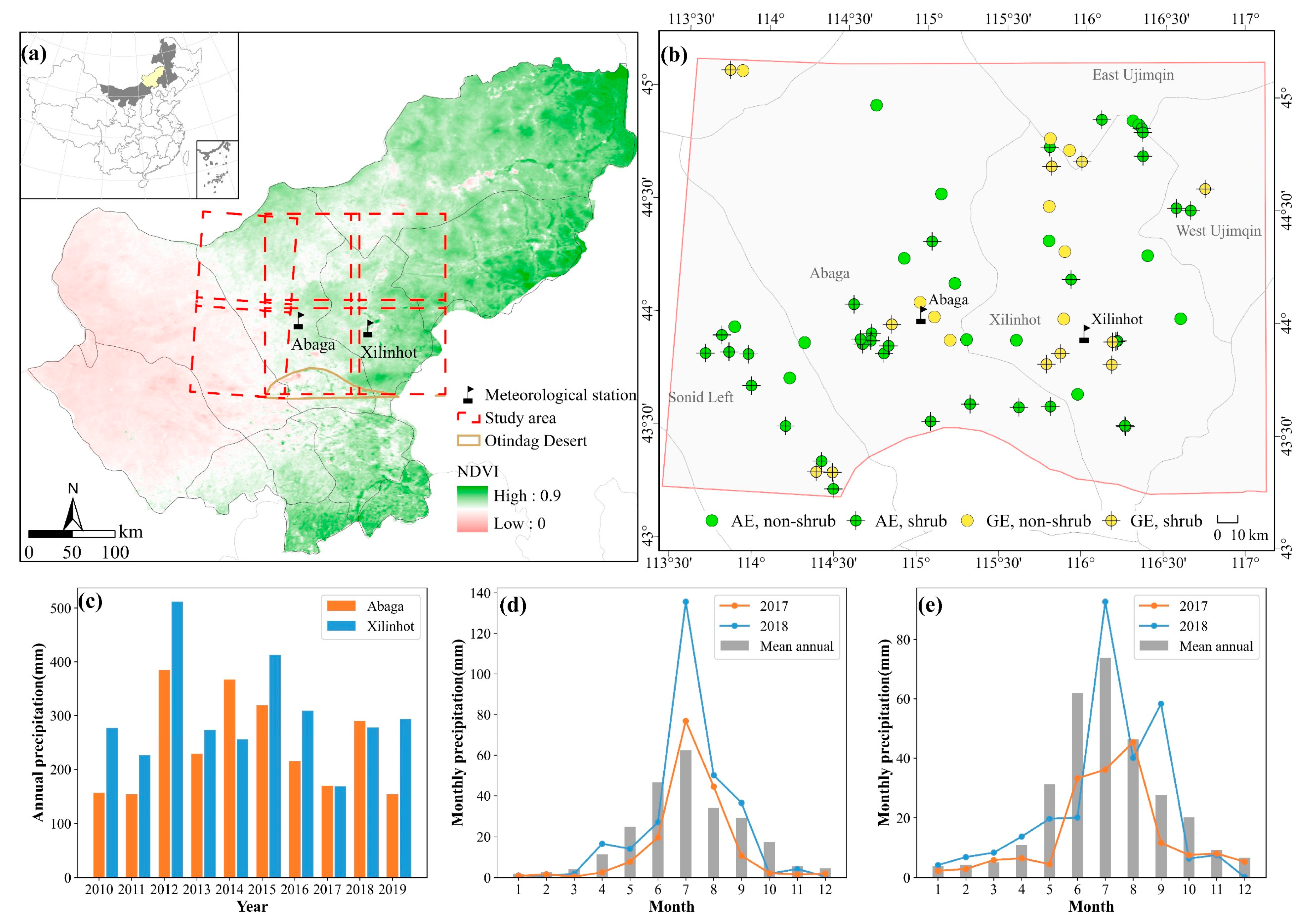
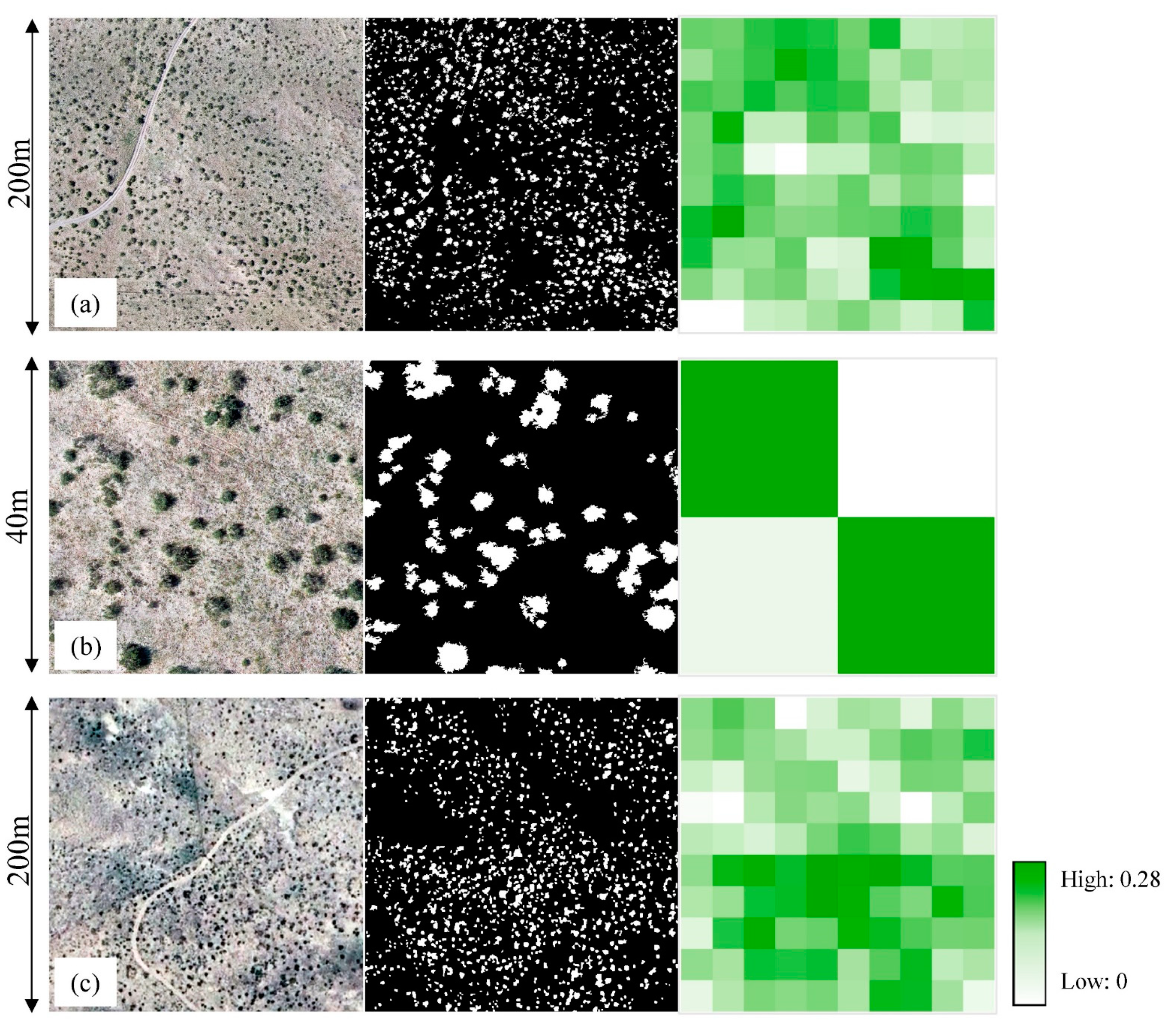
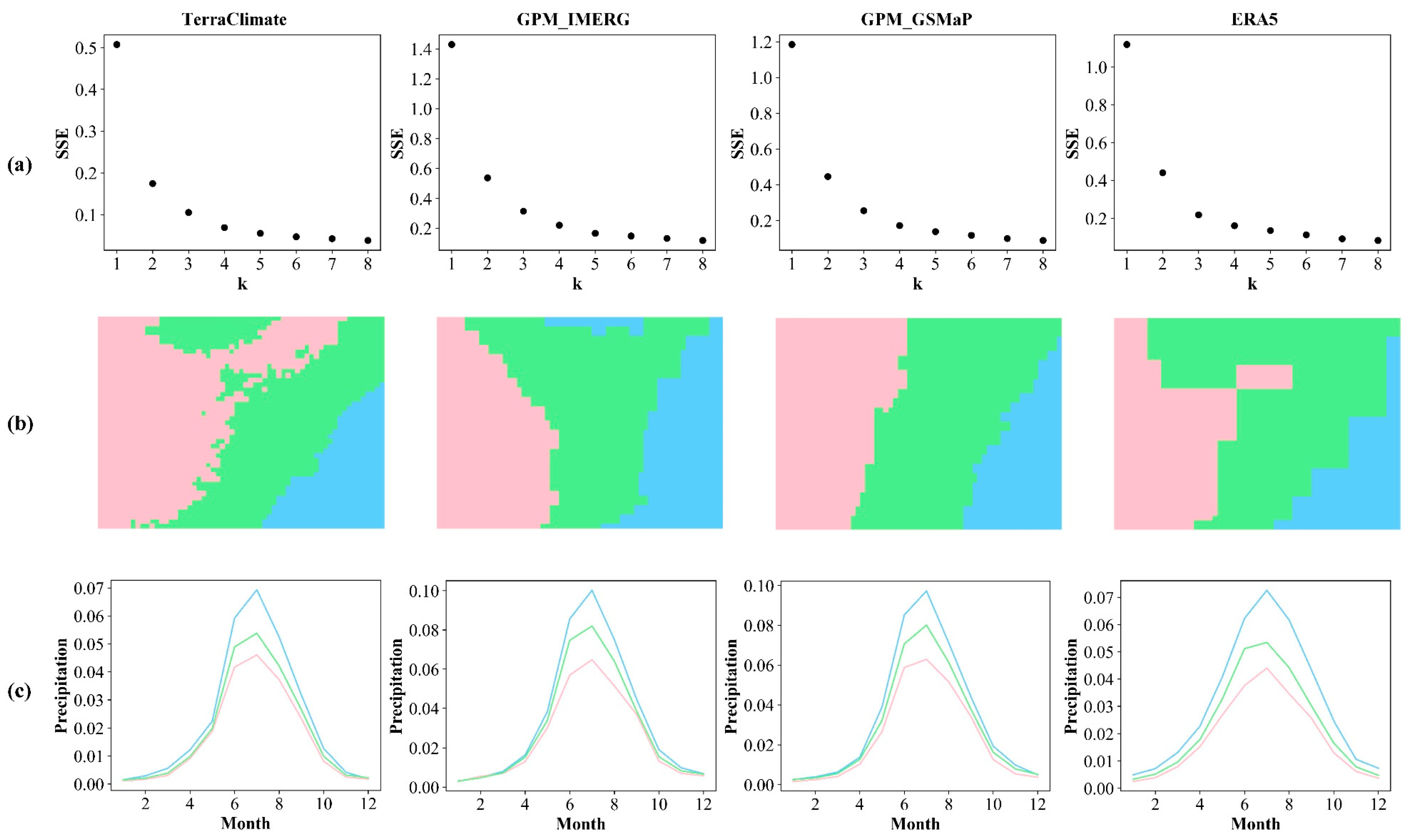

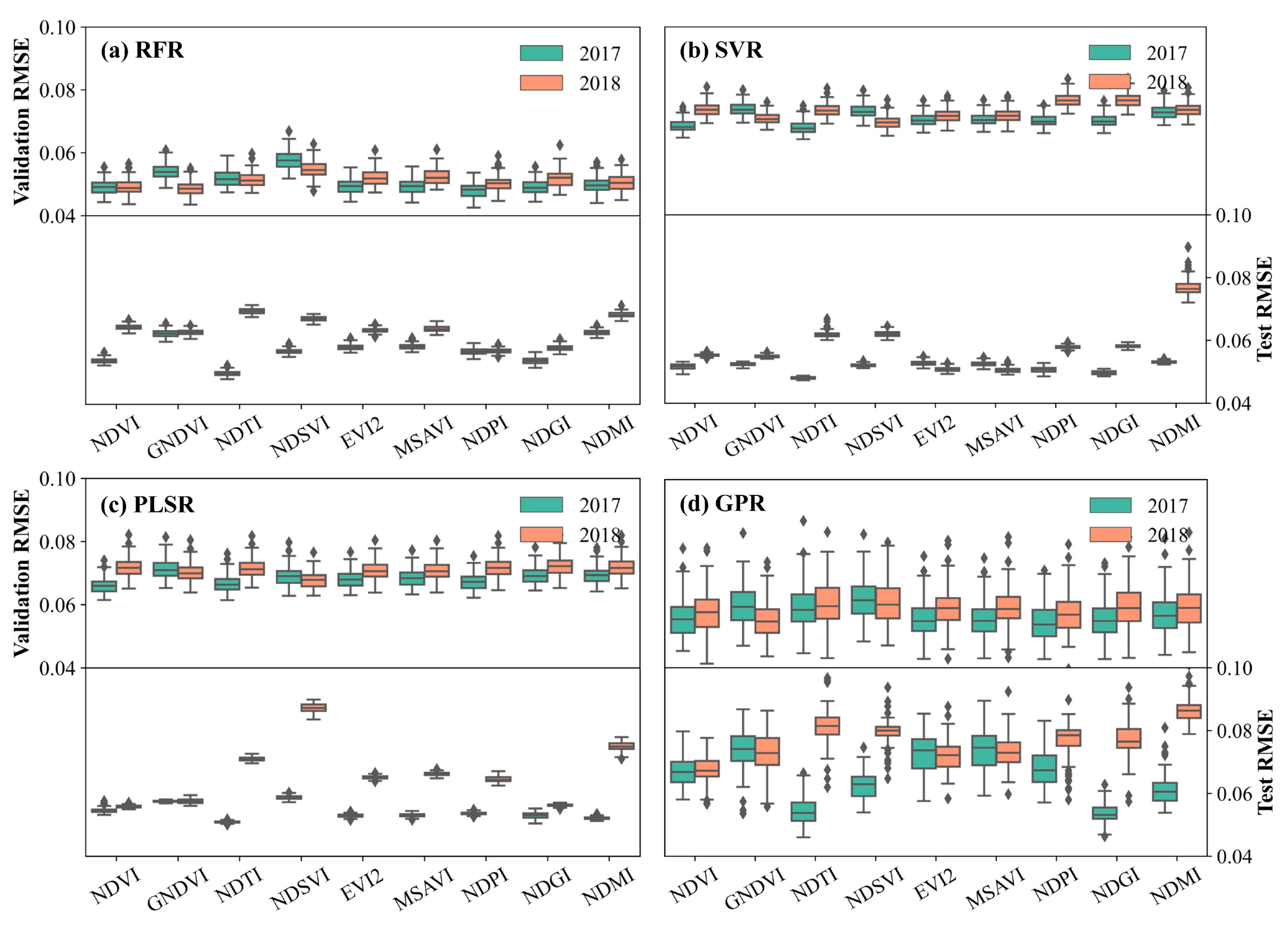

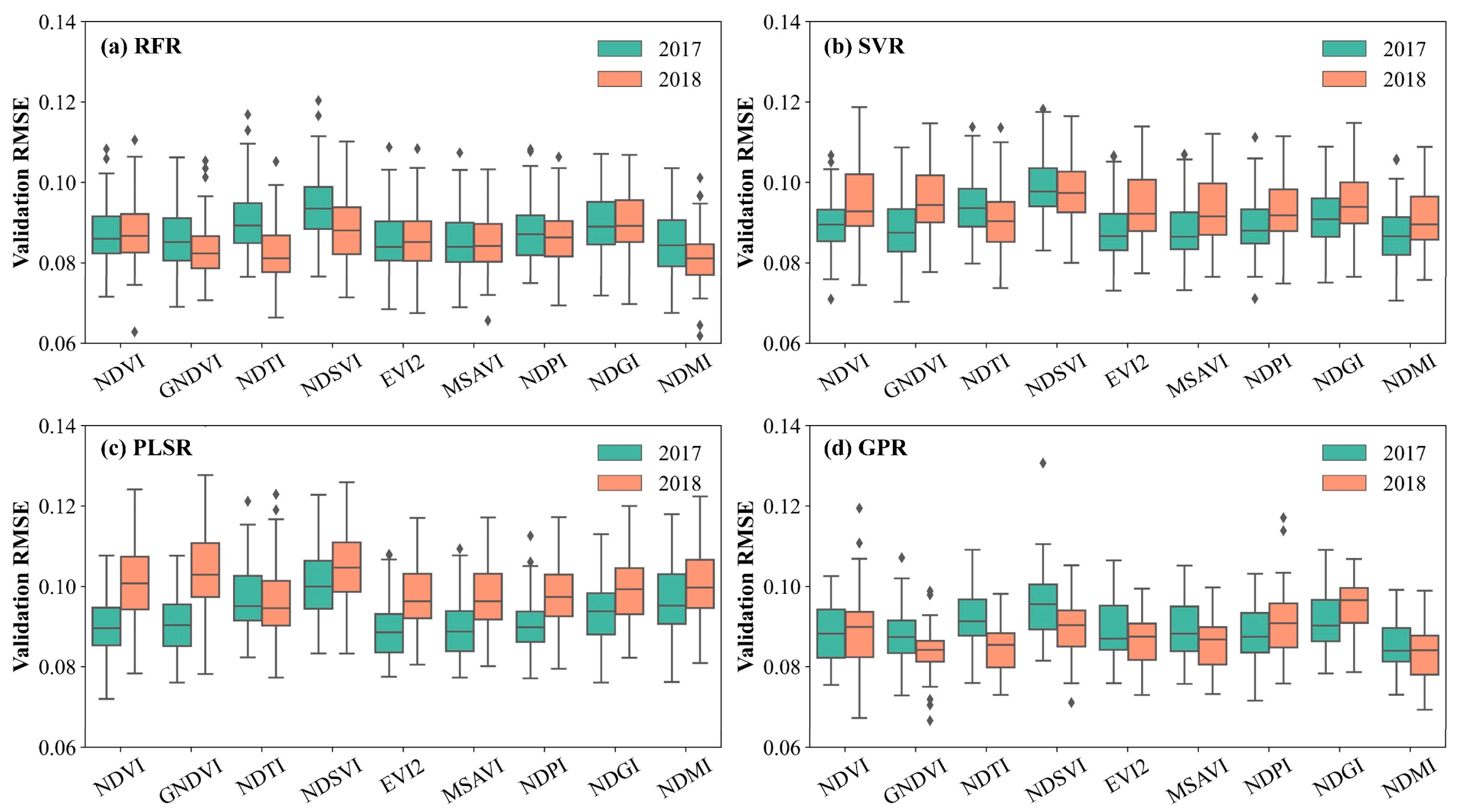



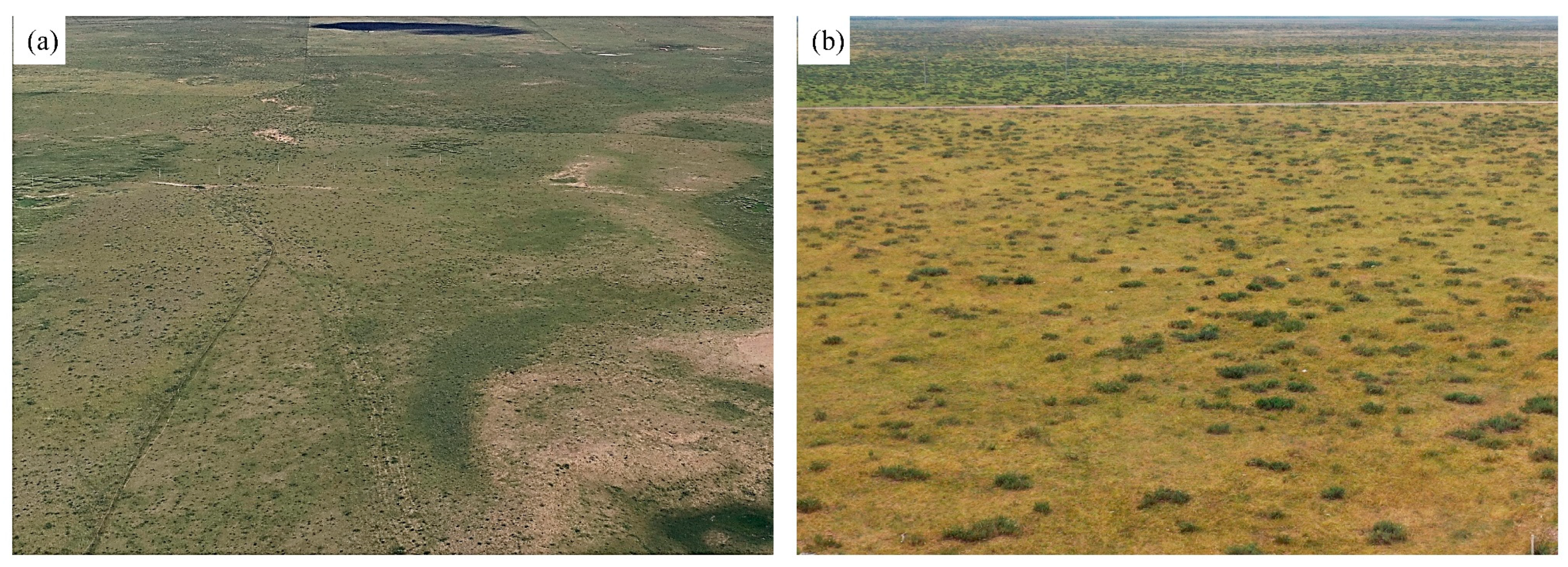
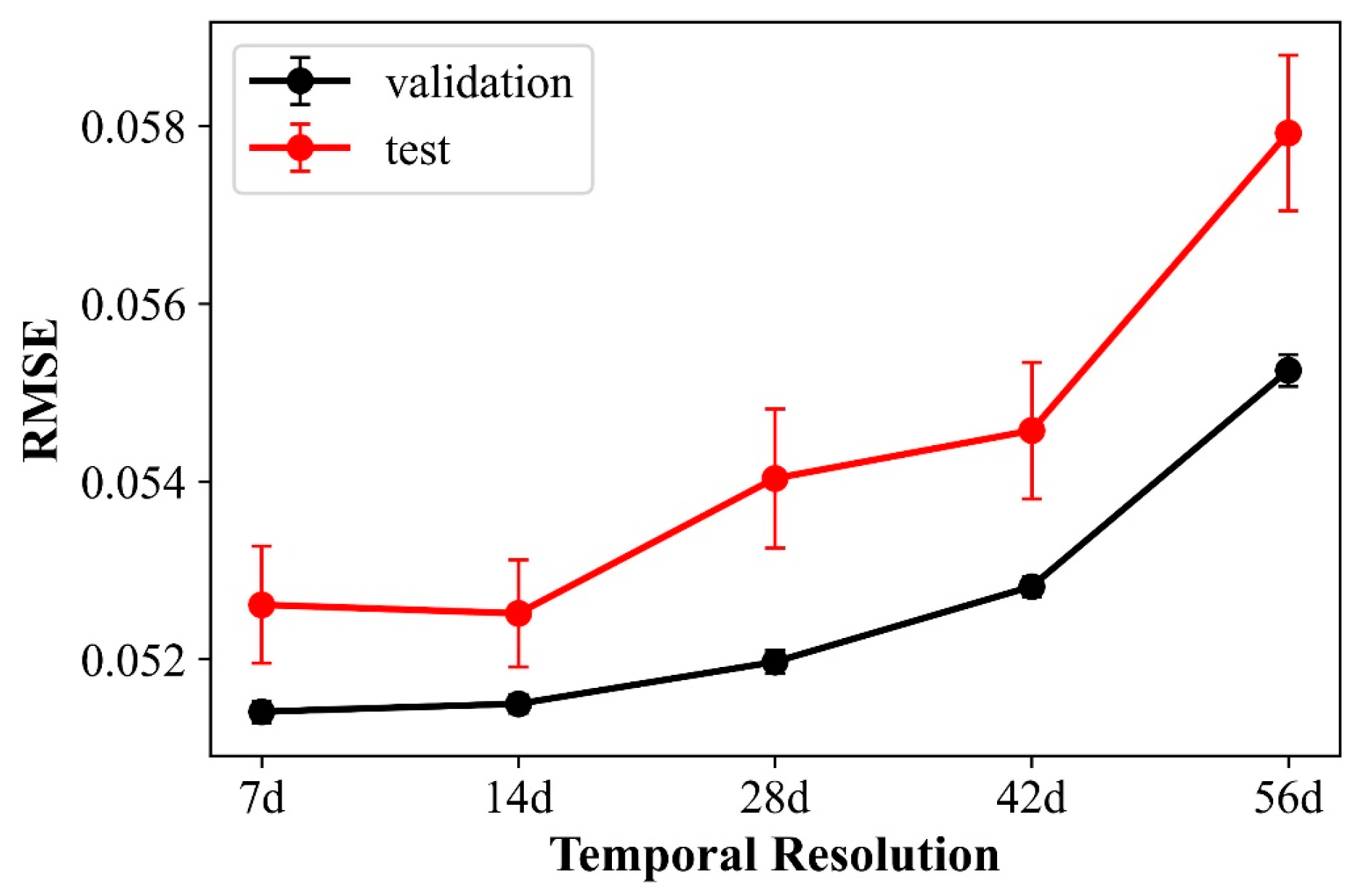
| Name | Temporal Resolution | Spatial Resolution | Cover Time |
|---|---|---|---|
| TerraClimate | monthly | ~5 km | 1958–2019 |
| GPM_IMERG | 3 h | ~10 km | 2000–now |
| GPM_GSMap | hourly | ~10 km | 2000–now |
| ERA5 | hourly | ~25 km | 1979–now |
| Type | Vegetation Index | Formula | Reference |
|---|---|---|---|
| Greenness Index | NDVI | [40] | |
| GNDVI | [41] | ||
| Yellowness Index | NDTI | [42] | |
| NDSVI | [43] | ||
| Background-adjusted Index | EVI2 | [44] | |
| MSAVI | [45] | ||
| NDPI | [46] | ||
| NDGI | [47] | ||
| Moisture Index | NDMI | [48] |
| Regression Methods | Parameter | Adjustment Range |
|---|---|---|
| RFR | max_features | 1, 2, 3, 4, 5, 6 |
| SVR | C | 0.1, 0.5, 1 |
| gamma | 0.001, 0.01, 0.05, 0.1 | |
| PLSR | n_components | 1, 2, 3, 4, 5, 6, 7, 8, 9, 10, 11, 12 |
| GPR | K(x1, x2) | Kernel’s hyperparameters were automatically optimized in model fitting |
| Accuracy | Validation | Test | ||||||
|---|---|---|---|---|---|---|---|---|
| Stgy.1 | Stgy.2 | Stgy.3 | Stgy.4 | Stgy.1 | Stgy.2 | Stgy.3 | Stgy.4 | |
| RMSE | 0.050 | 0.050 | 0.050 | 0.050 | 0.052 | 0.055 | 0.057 | 0.060 |
| OA | 0.830 | 0.824 | 0.831 | 0.830 | 0.764 | 0.797 | 0.755 | 0.746 |
| Precision | 0.797 | 0.793 | 0.795 | 0.795 | 0.800 | 0.815 | 0.792 | 0.801 |
| Recall | 0.964 | 0.960 | 0.973 | 0.970 | 0.917 | 0.946 | 0.917 | 0.886 |
| Mean0 | 0.024 | 0.023 | 0.026 | 0.025 | 0.056 | 0.045 | 0.058 | 0.050 |
Publisher’s Note: MDPI stays neutral with regard to jurisdictional claims in published maps and institutional affiliations. |
© 2022 by the authors. Licensee MDPI, Basel, Switzerland. This article is an open access article distributed under the terms and conditions of the Creative Commons Attribution (CC BY) license (https://creativecommons.org/licenses/by/4.0/).
Share and Cite
Gan, L.; Cao, X.; Chen, X.; He, Q.; Cui, X.; Zhao, C. Mapping Shrub Coverage in Xilin Gol Grassland with Multi-Temporal Sentinel-2 Imagery. Remote Sens. 2022, 14, 3266. https://doi.org/10.3390/rs14143266
Gan L, Cao X, Chen X, He Q, Cui X, Zhao C. Mapping Shrub Coverage in Xilin Gol Grassland with Multi-Temporal Sentinel-2 Imagery. Remote Sensing. 2022; 14(14):3266. https://doi.org/10.3390/rs14143266
Chicago/Turabian StyleGan, Liqin, Xin Cao, Xuehong Chen, Qian He, Xihong Cui, and Chenchen Zhao. 2022. "Mapping Shrub Coverage in Xilin Gol Grassland with Multi-Temporal Sentinel-2 Imagery" Remote Sensing 14, no. 14: 3266. https://doi.org/10.3390/rs14143266





